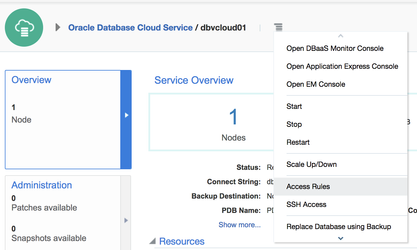...
The purpose of this Deployment guide is to demonstrate the way in which Dbvisit Standby 8.0 software can be used within the Oracle Database As A Service (DBaaS) space. In this guide, we focus on both the Primary and Standby databases hosted on DBaaS. In another document, we focus on 'On-Premise Primary' to Standby hosts on 'DBaaS'. A link that document can be found here
...
| Info |
|---|
| The setup will be from Single Instance Primary Databases to Single Instance Standby Databases with Datafiles stored on standard filesystems. However the options for configuring Dbvisit Standby in the Oracle Cloud are in no way limited to this, is it has simply been chosen for demonstration purposes. |
...
I generated a private and public set of key files using ssh-keygen from my local linux Linux machine.
| Code Block |
|---|
oracle@dbvlab01[/home/oracle]: ssh-keygen -b 2048 -t rsa -f oraclecloud Generating public/private rsa key pair. Enter passphrase (empty for no passphrase): Enter same passphrase again: Your identification has been saved in oraclecloud. Your public key has been saved in oraclecloud.pub. The key fingerprint is: 35:6b:e6:39:cd:06:c0:04:d9:7e:73:4d:85:80:33:ab oracle@dbvlab01.dbvisit.co.nz oracle@dbvlab01[/home/oracle]: |
...
Download the latest version of Dbvisit Standby for OEL6 and scp SCP to each of the cloud hosts.
...
In order for Dbvisit Standby to communicate between the 2 hosts, and to enable access to the GUI frontend, 3 ports need to be made available. These are 7890 (Dbvnet), 7891 (Dbvagent) and 4433 (dbvserver: GUI). To do this, navigate to the summary page of each host and choose Access Rules from the menu. From here, click the "create rule" button and fill in the details. The example below shows 1 rule per a port range named dbvisit_ports. It is also possible to create 1 rule per port and name them accordingly.
At this stage, these servers are ready for the next stage of installing the software.
...
| Code Block |
|---|
[oracle@dbvcloud02 ~]$ unzip dbvisit-standby8.0.12-el6.zip Archive: dbvisit-standby8.0.12-el6.zip inflating: dbvisit-standby8.0.12-el6.tar [oracle@dbvcloud02 ~]$ cd dbvisit/installer/ [oracle@dbvcloud02 installer]$ ls -lrt total 2768 -rwxr-x--- 1 oracle oinstall 2833364 May 11 02:16 install-dbvisit [oracle@dbvcloud02 installer]$ ./install-dbvisit |
On the node dbvcloud02, the dbvserver (option 5) was also installed. Alternatively, a 3rd host could be configured for hosting the dbvserver. Careful to ensure during the dbvnet configuration on each node that the correct hosts are specified for source and destination. The output from the installation on node2 is shown below for reference.
...
| Code Block |
|---|
[oracle@dbvcloud01 installer]$ cd /usr/dbvisit/dbvnet [oracle@dbvcloud01 dbvnet]$ ./dbvnet -d start [oracle@dbvcloud01 dbvnet]$ cd ../dbvagent/ [oracle@dbvcloud01 dbvagent]$ ./dbvagent -d start [oracle@dbvcloud01 dbvagent]$ ps -ef|grep -i dbv oracle 6250 1 0 02:23 ? 00:00:00 ./dbvnet -d start oracle 6388 1 0 02:24 ? 00:00:00 ./dbvagent -d start |
Additionally, on the standby node, start the dbvserver process
...
Return to the Main Menu and then proceed on to creating the DDC
| Note | ||||||
|---|---|---|---|---|---|---|
In this Guide, Oracle version 12.1.0.2 has been used and the init.ora parameter "encrypt_new_tablespaces" set to CLOUD_ONLY. This means that any new tablespaces created will be encrypted and it is prudent to copy the relevant wallet files from the primary server to the standby server. The $ORACLE_HOME/network/admin/sqlnet.ora file needs to be updated to reflect the location of these wallet files and if multiple Databases are to be installed then $ORACLE_SID should be used in the location to distinguish between wallets. e.g.
Then copy the wallet files to the standby server.
This prevents the following error during the standby creation phase.
|
...
Firstly Create a directory for ARCHSOURCE and ARCHDEST parameters. The former is only required in the event of a Graceful switchover , when the Primary becomes a Standby database. In this example, the same location is created on each server.
...
Select your configuration, New Database and edit the spfile SPFILE parameters if required and then check there is enough space in the Source and Dest temp locations.
...
To Create the Standby database with the command line is shown below
...
Start the Daemons for automatic send/apply from the GUI Database Actions Tab.
The lightening "lightning bolt" icon manages the daemon processes as shown below.
...
Select the Standby Host, review the current status and Select Start READ ONLY.
...
3.6 Activate the Standby Database
It is possible to activate the Standby Database and make it become the new Primary. This is also called failover to the standby database.
...


